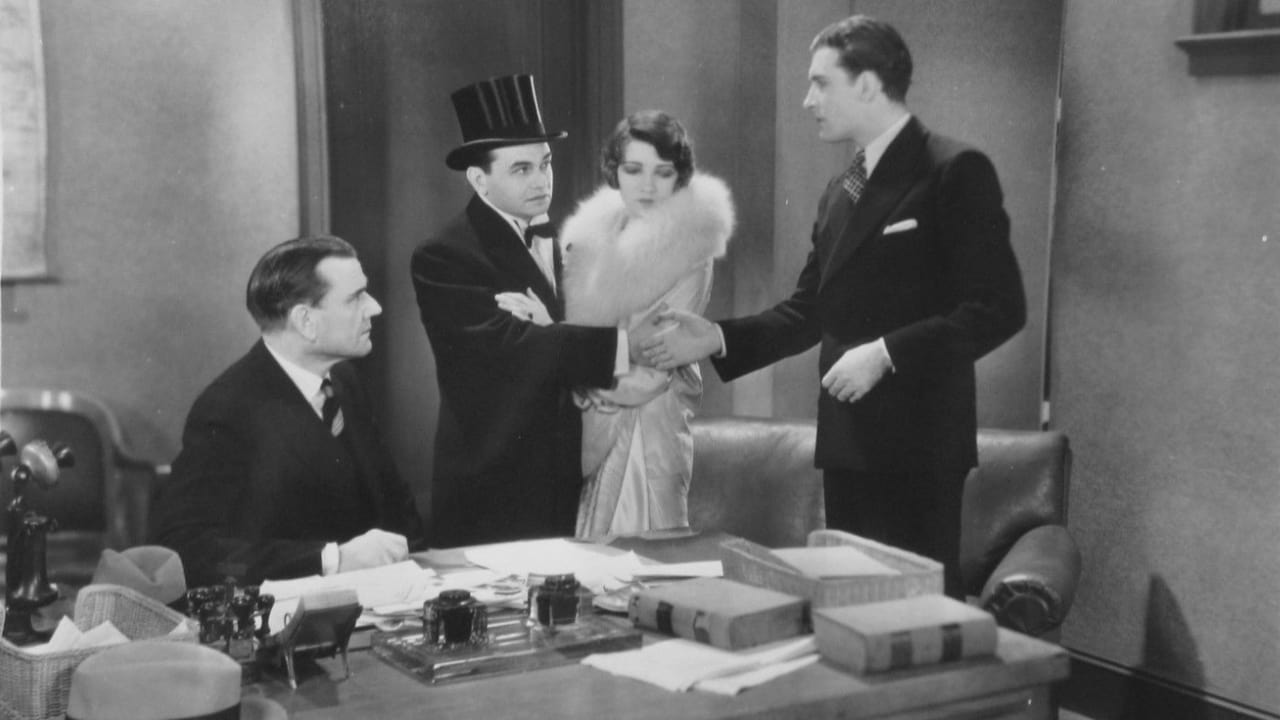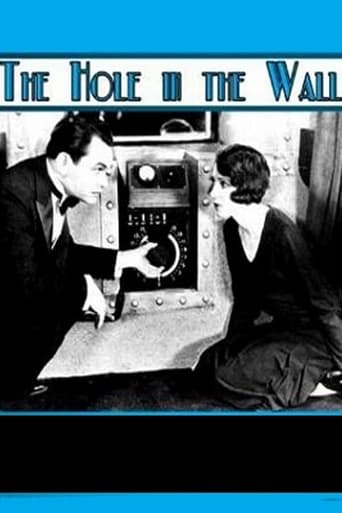Smartorhypo
Highly Overrated But Still Good
Leoni Haney
Yes, absolutely, there is fun to be had, as well as many, many things to go boom, all amid an atmospheric urban jungle.
Lucia Ayala
It's simply great fun, a winsome film and an occasionally over-the-top luxury fantasy that never flags.
Edwin
The storyline feels a little thin and moth-eaten in parts but this sequel is plenty of fun.
JohnHowardReid
The Great Depression put an end to the huge onslaught of Broadway mystery and suspense plays which reached a peak in 1927. These plays do not generally translate at all well as film noir, although exceptions can be made for The Bat (1926) and The Hole in the Wall (1930). The film version of "The Hole in the Wall" was formerly available on a most interesting VintageFilmBuff DVD. You've all heard of a part-talkie. Well, the VFB release is actually a part-silent, roughly 95% talking, yet 5% silent — and by "silent" I mean dead silent. Except for two sequences, namely music in a night club, and crash effects in the El — there is absolutely no sound at all in the silent action footage that is cut into the movie from time to time. However, 'The Hole in the Wall' does most effectively showcase some really spooky sets. These alone make the movie worth viewing. The characters are somewhat creepy too, but the screenplay chickens out on allowing them to reach their full noir potential. Particularly disappointing is the "geek" (v. Nightmare Alley) who is given a great build-up as a potential menace (and even enacts that part in a publicity still with Donald Meek), but is then allowed to slip away into almost nothing. Edward G. Robinson, of course, is at home as the heavy with a heart, while Claudette Colbert looks appropriately unglamorous as the revengeful convict-turned-fake-mystic.
calvinnme
At times the melodrama is downright hammy and there is really nothing unique about the plot - a group of con artists using a psychic/medium scam to bilk rich patrons, and a girl (Claudette Colbert as Jean) wrongly accused of theft by a rich woman to keep her away from her son, thrown into prison as a result, embittered and swearing revenge when she is released, and joining up with the gang. What is unique about all of this is how sound is used for the first time to give depth to the story.The group of thieves keep a howling madman that they got from a carnival around for the séances, and when he lets out a yowl it is really creepy. The end, with Jean the fake spiritualist actually making contact with the dead, and mouthing the dead man's real words of warning was surprising and could not have been done effectively in a silent film. As for the visuals, they are a mixed bag. For example, there is a train wreck scene that is done oddly. Time is taken to get a real feel of the human toll of the wreck with close-ups of the passengers before and of the wreckage afterwards. But the accident itself looks very fake and amateurish - the train is obviously a miniature model. The interior art design is a bit of a hoot too - I mean who is that supposed to be a statue of in the séance room? It rather looks like Buddha, but not exactly. Then there is one big goof by the thieves that actually draws the police like flies to the "hole in the wall" gang. Such so-called smart crooks would never make such a ridiculous mistake.Edward G. Robinson is really great as "The Fox". For the first time you can see and hear a gangster in a film, and his speech and mannerisms are spot on and very natural. His sweet proposal to Jean, her gentle rejection, and his dignified acceptance of her decision is the acting highlight of the film. Oddly enough Robinson is fourth billed under Claudette Colbert, although this is the first talkie for both of them, neither having been particularly successful in silent films. Besides the familiar faces working their way up, it's interesting and a bit sad to see unfamiliar faces working their way down. David Newell, billed over Robinson, completely fails to impress. He does stand out though because of his halting speech, detached performance, and a fake smile that seems to be stapled to his face. I just can't see this guy staying on Jean's mind since they were childhood sweethearts and her passing up The Fox for this cardboard cutout.The whole thing plays out a bit like an experiment in early sound film, and in December 1928 when it was shot that is pretty much what it was - even director Robert Florey looked at it that way, trying a number of different new techniques and players in this one film so he would know what would work. If you enjoy the early talkies I recommend you give this one a look.
ackstasis
Robert Florey began his career with a number of celebrated silent avant garde shorts films – including 'The Love of Zero (1927)' and 'The Life and Death of 9413, a Hollywood Extra (1928)' – all strongly indebted to 'The Cabinet of Dr Caligari (1920)' and German Expressionism. Therefore, it's a little disappointing that his features aren't all that interesting. 'Murders in the Rue Morgue (1932)' was visually stunning, thanks largely to cinematographer Karl Freund, but was stunted by ham- fisted acting and bad dialogue (perhaps a side-effect of the director's poor command of English). 'The Hole in the Wall (1929),' bound by the restrictions of early sound technology, even lacks Florey's usual visual flair – the only exception is the entrance to Madam Mystera's haunt, which has the warped ceiling of a 'Caligari' set. Perhaps the primary interest here is the film's cast, which includes two future stars in their first talkie.The story itself is vaguely interesting: a shrewd shyster called The Fox (Edward G. Robinson) recruits a wrongly-accused ex-con (Claudette Colbert, in her second role) to help perpetrate a Spiritualism scam. (Spiritualism was all the rage in the 1920s, its greatest proponent being author Arthur Conan Doyle, who used his Professor Challenger character to promote the field in his 1926 novel "The Land of Mist"). Unfortunately, there's very little tension in this film. The possible drowning of a little girl should have made for suspenseful storytelling, and Florey was generally an expert at editing rhythmic montages, but here there's no urgency in his cross-cutting, and the dialogue unfolds with unnatural slowness, as though to make certain that the sound equipment is catching everything. Finally, I was very much surprised that, after an hour of exposing Spiritualism as a fraud, the film suddenly tosses in an authentic psychic moment, and nobody thinks twice about it.
HarlowMGM
THE HOLE IN THE WALL is a crime melodrama where only one gun is seen fleetingly. Edward G. Robinson stars as "The Fox", leader of a small gang who has found a new racket that's a cinch, running a fake spiritual medium which finds out information about the belongings of rich believing clients which he then steals. When his "Madame Mysteria" is killed in a railway crash (an incredibly cheap "special effect" badly done with toys which even 1929 audience must have laughed at) he is without a female front for the organization. Within hours into the dungeon-like headquarters/business walks Claudette Colbert, fresh out of jail after being falsely accused of theft. Unable to find a job, she comes the headquarters having heard she might could find a place in the racket from sources she knew in the slammer. Robinson immediately sees her as his new medium and after a practice bit, she agrees to do it - in exchange for her own illegal scheme - she wants to kidnap the granddaughter of the woman who framed her and keep her, raising her as a crook she was accusing of being.This 1929 melodrama is quite bad and yet rather interesting. This is mainly thanks to top-billed Claudette Colbert, clearly a natural for films, she gives a smooth performance in a highly wavering film. Edward G. Robinson does come not off quite as well and he is hampered by the heavy makeup often given men in mediocre early talkies, black lips and all. It's easy to see why Paramount kept her and passed on him. The big surprise is David Newell, the second lead, who does a very competent job as the good-looking young reporter who turns out to have been an old beau of Claudette's. Newell is very much the type of leading man Paramount loved - he definitely foreshadows Ray Milland and Fred MacMurray - yet his stint as a Paramount player was brief (he appears to have been let go during the massive cutbacks of late 1930 which saw Jean Arthur, Mary Brian, and many other secondary performers canned at the studio.) Newell was playing small parts in 1932 and by 1933 he was beginning an extremely long career as an unbilled bit player.Meek character actor Donald Meek makes a rather unconvincing gang member and then there is a character supposedly purchased from a freak show named "Dogface" who is kept around inexplicably since he never really has anything to do in the story. Louise Closser Hale's grande dame is written so imperviously she's barely given pause to the fact that her granddaughter is missing with no leads. Actress Nellie Salvage, a minor player in silent films, has her only talking role as the ill-fated Madame.The print I viewed was in quite good shape, however it ran only 63 minutes although there was no continuity problem suggesting it may have never been the 73 minutes IMDb lists it at. The movie is also a complete talkie, although there are a few seconds of non-sound when characters appear to be conversing but this was probably dropouts in the print.The movie ends somewhat abruptly, as often appears to be the case in early Paramount talkies. The set designer and cinematographer do a considerably better job creating a fairly spooky, creepy ambiance than does director Florey. Worth seeing only as a curio - or for fans of the cast.

